Please sign in with Google to view the map.
Sign in with GoogleMUHBA – Barcelona City History Museum in Plaça del Rei
Walk through Roman streets beneath Plaça del Rei at MUHBA, Barcelona’s city history museum housed in medieval palaces and Gothic architecture
About Barcelona City History Museum MUHBA Plaça del Rei
The Barcelona City History Museum, known locally as the Museu d’Història de Barcelona (MUHBA), is located in the heart of the Gothic Quarter (barri gòtic) within the historic Jewish Quarter (El Call). This museum offers a deep dive into the history of Barcelona, from its Roman origins as Barcino to its medieval transformation and modern evolution.
MUHBA is housed in a cluster of medieval buildings surrounding Plaça del Rei, one of the most iconic squares in the city. Known for its Gothic architecture and open-air steps that resemble a natural amphitheatre, this square was once the courtyard of the royal palace and later a bustling straw and hay market. Today, it’s the gateway to one of the most immersive history museums in Barcelona.
The museum’s highlight is its underground Roman ruins, accessible via a glass walkway that guides visitors through the preserved streets of ancient Barcino. You’ll encounter remnants of Roman baths, wine-making facilities, laundry workshops, and city walls — making MUHBA one of the most unique archaeological museums in Barcelona.
MUHBA Buildings & Architectural Legacy
- Casa Padellàs: A 15th-century Gothic palace originally located on Carrer Mercaders. It was dismantled and relocated to Plaça del Rei in 1931 due to the construction of Via Laietana. It now serves as the museum’s entrance and exhibition space.
- Count’s Royal Palace Complex: Once the residence of the Counts of Barcelona and Kings of Aragon, this includes:
- Tinell Hall: A grand ceremonial hall built between 1359 and 1362 by King Peter IV.
- Palatine Chapel of Saint Agatha: Constructed around 1302 under King James II, featuring a stunning Gothic altarpiece.
- Lloctinent Palace: Built in 1549 by the Catalan Generalitat under Charles V, used by the viceroy of Catalonia.
MUHBA is more than a museum — it’s a journey through Roman archaeology in Barcelona, medieval palaces, and Gothic architecture. It’s ideal for those seeking a quiet, immersive experience in the Barcelona Gothic Quarter, especially history lovers, students, and families.
Note: MUHBA should not be confused with the History of Catalunya Museum (MHCAT), which offers a broader overview of Catalan life from the Iberian tribes to the present day.
While MUHBA showcases the impressive remains of Barcino, it’s important to note that Roman Barcelona was not the capital of Roman Hispania. That title belonged to Tarraco — present-day Tarragona — which served as the administrative and political center of the region. For those interested in a deeper dive into Roman history, a day trip to Roman Tarragona offers a chance to explore amphitheatres, aqueducts, and temples that once defined the Roman Empire’s presence in Spain.
Rainy day tip: MUHBA is one of the best indoor museums in the Gothic Quarter. Its underground Roman ruins and medieval halls offer a quiet, atmospheric escape from the weather — and it’s free to enter on the first Sunday of every month.
Image Gallery For Barcelona City History Museum MUHBA Plaça del
Click on any of the 96 images to open full screen gallery player. Note that viewing images is subject to our Fair Use Policy.
Visiting Barcelona City History Museum MUHBA Plaça del Rei
Visiting the Barcelona City History Museum (MUHBA) in Plaça del Rei is like stepping into a time machine beneath the Gothic Quarter. This museum invites you to walk through the underground Roman ruins of ancient Barcino, explore medieval palaces, and stand in the very halls where Catalan royalty once ruled. Whether you're a history lover, a curious traveler, or seeking shelter on a rainy day, MUHBA offers one of the most immersive and atmospheric museum experiences in Barcelona — and it's free to enter on the first Sunday of every month.
Plaça del Rei Entrance & Corridor Exhibits
The entrance to the Barcelona City History Museum (MUHBA) is through the Gothic palace of Casa Padellàs, relocated stone-by-stone to Plaça del Rei. This square, once the courtyard of the royal palace, sets the tone with its Gothic architecture and medieval ambiance. Inside, a vaulted corridor leads visitors toward the basement, lined with introductory exhibits that showcase Roman stone carvings, architectural capitals, and funerary reliefs from ancient Barcino.
These corridor displays offer a preview of the Roman archaeologysculptures, ceramics, and urban artifacts that reflect everyday life in Roman Barcelona. The lighting and stone walls create a quiet, immersive atmosphere — perfect for easing into the museum’s underground journey.
Roman Streets & Basement Ruins of Ancient Barcino
Descending into the basement of MUHBA reveals the preserved remains of Barcino, the Roman settlement that preceded modern-day Barcelona. A raised walkway guides visitors through a network of Roman streets, stone walls, and urban infrastructure dating back to the 1st and 2nd centuries AD. These ruins include laundry vats, wine-making facilities, storage rooms, and drainage channels, offering a rare glimpse into daily life in Roman Hispania.
Interpretive panels and lighting highlight key features such as Latin inscriptions, column bases, and architectural fragments reused in later medieval construction. The site’s stratigraphy reveals layers of urban development, making this one of the most immersive archaeological museums in Barcelona. The ruins are fully accessible via modern walkways and are ideal for history lovers, students, and families exploring Roman archaeology in Barcelona.
The basement’s lighting design plays a subtle but essential role in the visitor experience. Soft, natural-toned white light is used throughout the underground walkways, enhancing the texture and color of the Roman stonework. This lighting brings out the warm ochres, cool greys, and earthy browns of the ancient walls and foundations, allowing visitors to appreciate the craftsmanship and layered history embedded in each block. The gentle illumination also preserves the quiet, contemplative atmosphere of the space, making it ideal for slow exploration and reflection.
Counts Royal Palace – Tinell Hall
One of the most striking spaces in the MUHBA Plaça del Rei complex is the Tinell Hall, part of the Counts Royal Palace. Built between 1359 and 1362 by King Peter IV of Aragon, this vast ceremonial hall was used for royal receptions, court gatherings, and public events. Its grand scale and sweeping Romanesque arches make it one of the finest examples of medieval palace architecture in Barcelona.
The hall’s vaulted stone ceiling and exposed walls evoke the power and prestige of the Kings of Aragon, who ruled from this very site. Today, Tinell Hall hosts rotating exhibitions on medieval Barcelona, including themes like urban transformation, religious power, and the city’s role as a Mediterranean capital during the Middle Ages.
Visitors can explore displays of religious art, historical maps, and architectural models that trace the evolution of the city from the 3rd to the 15th century. The hall’s immersive lighting and interpretive panels make it a highlight for anyone interested in Barcelona’s medieval history and its transition from Roman outpost to Gothic metropolis.
The lighting design in Sala Tinell plays a subtle but powerful role in shaping the visitor experience. Rich red hues are used throughout the hall to evoke a sense of royalty and ceremony, echoing its original function as a space for medieval court gatherings and royal audiences. The warm tones highlight the Romanesque arches and stone textures, creating an atmosphere that feels both majestic and intimate — a fitting tribute to the Counts of Barcelona and the Kings of Aragon who once ruled from this very space.
Palatine Chapel of Saint Agatha
The Palatine Chapel of Saint Agatha is one of the architectural jewels of the MUHBA Plaça del Rei complex. Built in 1302 during the reign of King James II of Aragon, this Gothic chapel was designed as a royal place of worship and remains one of the most atmospheric spaces in the Barcelona City History Museum.
The chapel features soaring Gothic arches, stained glass windows, and a richly detailed altarpiece by Jaume Huguet, a masterpiece of Catalan Gothic painting. The altarpiece depicts scenes from the life of Saint Agatha and other biblical narratives, framed in gold and set beneath a vaulted ceiling that amplifies its grandeur.
Today, the chapel hosts exhibitions that explore medieval Barcelona, its religious institutions, and its role as a Mediterranean capital in the Middle Ages. Visitors can view architectural models, urban planning maps, and interactive displays that trace the city’s transformation from Roman outpost to Gothic stronghold.
The chapel’s immersive lighting — including a striking wash of purple — enhances the Gothic architecture and makes the space feel both sacred and theatrical, especially when viewed against the backdrop of the altarpiece and stained glass windows.
Allow one to two hours to fully explore all floors and rooms of the museum. The underground route is extensive and thoughtfully curated, guiding you through layers of Roman urban life — from wine production and laundry vats to drainage systems and reused architectural fragments. The soft white lighting enhances the natural stone tones of the ruins, revealing subtle textures and colors that bring the ancient city of Barcino to life. Whether you're pausing to read inscriptions or simply soaking in the quiet atmosphere, this part of MUHBA offers a rare chance to walk through history at your own pace, making it one of the most immersive archaeological experiences in Barcelona.
Barcelona History Museum MUHBA plaça del Rei Opening Hours
- Tuesday to Saturday: 10:00h to 19:00h.
- Sunday: 10:00h to 20:00h.
- Closed: Monday's, 1st January, 1st May, 24th June and 25th December.
Barcelona History Museum MUHBA plaça del Rei Free Days
- 1st Sunday of the month all day
- Every Sunday after 15:00h
- 24th September
Accessibility and what to take with you
The Barcelona City History Museum (MUHBA) is fully accessible for visitors with reduced mobility or pushchairs. While the museum’s layout spans multiple levels and historic buildings, elevators are available to reach all exhibition spaces. However, due to the architectural design of the site, visitors using mobility aids may need to backtrack to the elevator rather than follow the circular route through the museum’s interconnected rooms and corridors.
There is a bicycle anchorage at Plaça del Àngel (coordinates: 41.383918, 2.178326), located next to the Jaume I Metro entrance. That said, this is not a location I would recommend for leaving a bicycle unattended for long periods.
Lockers are available at the museum entrance for storing personal items. When I visited, I was allowed to carry my small 10L museum rucksack inside without issue — though larger bags may need to be stored.
To make the most of your visit, bring headphones for the audio guide, which offers rich commentary on the Roman ruins, medieval architecture, and historical artifacts throughout the museum.
Tickets for Barcelona City History Museum MUHBA Plaça del Rei
The Barcelona Card: 25+ Museums and Free Public Transportation ticket includes entry to the Barcelona City History Museum MUHBA Plaça del Rei museum.
Barcelona City History Museum MUHBA Plaça del Rei Summary of Prices
Getting to Barcelona City History Museum MUHBA Plaça del Rei
Address: Plaça del Rei s/n, 08002 Barcelona
The nearest TMB Metro station is Jaume I on the yellow (L4) line. From the metro exit, walk up Carrer del Veguer from Baixada de la Llibreteria to reach Plaça del Rei, nestled in the heart of the Gothic Quarter.
For public transport, use a T-Casual card for single journeys or opt for the Hola Barcelona Travel Card for unlimited travel across metro, bus, tram, and train networks — ideal for short stays and museum hopping.
Documents for MUHBA Plaça del Rei
Map for Barcelona City History Museum MUHBA Plaça del Rei
Weather for Barcelona City History Museum MUHBA Plaça del Rei
Where to stay near Barcelona City History Museum MUHBA Plaça del Rei
Nearby Attractions to Barcelona City History Museum MUHBA Plaça del Rei
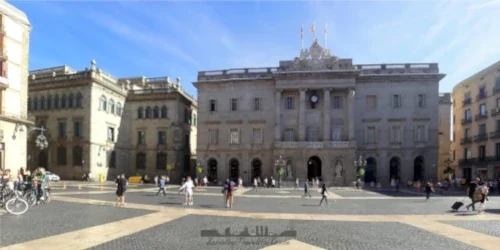 METRO
METRO
Barcelona Town Hall & Plaça Sant Jaume Guide
Explore Barcelona’s administrative heart at Plaça Sant Jaume, home to the City Hall and Generalitat Palace. Free guided tours of the historic City Hall interior available
Read more >
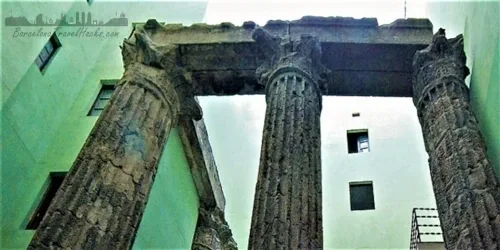 METRO
METRO
MUHBA Temple of Augustus – Hidden Roman Columns
2000-Year-Old Roman Temple ruins in Barcelona. Hidden Gothic courtyard with towering columns from ancient Barcino. Free to visit and rich in Roman heritage
Read more >
 METRO
METRO
Barcelona Roman Wall | Gothic Quarter Walking Route
Explore Roman wall remains of ancient Barcino in Barcelona’s Gothic Quarter, from Plaça Ramon Berenguer III to the Sea Gate at Plaza dels Traginers
Read more >
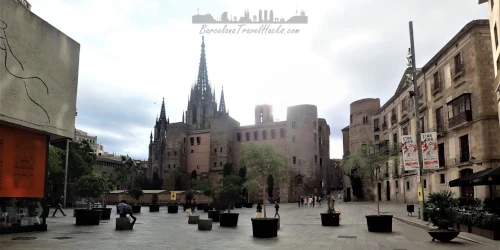 METRO
METRO
Barcelona Cathedral | Gothic Landmark in the Heart of El Gòtic
Visit Catedral de Barcelona in the Gothic Quarter. Discover cloisters, rooftop views, Santa Eulàlia’s crypt, and centuries of Gothic architecture and history
Read more >
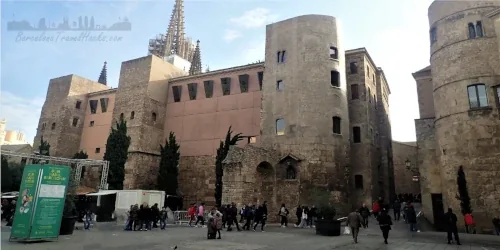 METRO
METRO
Casa de la Ardiaca – Hidden Gem & Photo Spot in Barcelona
Scenic courtyard, rooftop views & modernist mailbox. A Gothic hidden gem beside the cathedral with archives, Roman walls & wedding-worthy photo spots
Read more >
 METRO
METRO
Museu Frederic Marès – Barcelona's Sculpture & Collector’s Museum
Explore Museu Frederic Marès in Barcelona’s Gothic Quarter. Discover religious art, carved sculptures, and rare collectibles in a historic royal palace
Read more >
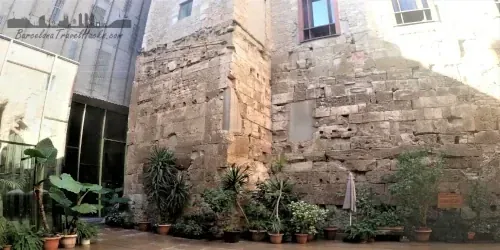 METRO
METRO
MUHBA Porta de Mar – Roman Sea Gate & Thermal Baths
Explore Roman ruins in Barcelona’s Gothic Quarter. Free museum with 2000-year-old sea gate, thermal bathhouse remains, and trade history from ancient Barcino
Read more >
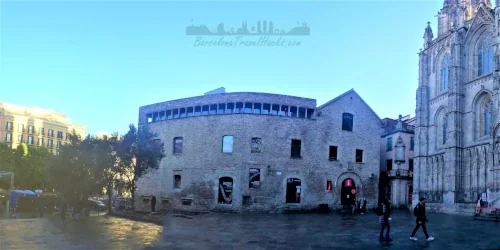 METRO
METRO